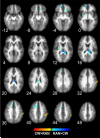Greater anterior insula activation during anticipation of food images in women recovered from anorexia nervosa versus controls
- PMID: 23993362
- PMCID: PMC3880160
- DOI: 10.1016/j.pscychresns.2013.06.010
Greater anterior insula activation during anticipation of food images in women recovered from anorexia nervosa versus controls
Abstract
Individuals with anorexia nervosa (AN) restrict food consumption and become severely emaciated. Eating food, even thinking of eating food, is often associated with heightened anxiety. However, food cue anticipation in AN is poorly understood. Fourteen women recovered from AN and 12 matched healthy control women performed an anticipation task viewing images of food and object images during functional magnetic resonance imaging. Comparing anticipation of food versus object images between control women and recovered AN groups showed significant interaction only in the right ventral anterior insula, with greater activation in recovered AN anticipating food images. These data support the hypothesis of a disconnect between anticipating and experiencing food stimuli in recovered AN. Insula activation positively correlated with pleasantness ratings of palatable foods in control women, while no such relationship existed in recovered AN, which is further evidence of altered interoceptive function. Finally, these findings raise the possibility that enhanced anterior insula anticipatory response to food cues in recovered AN could contribute to exaggerated sensitivity and anxiety related to food and eating.
Keywords: Functional magnetic resonance imaging (fMRI); Interoception; Neuroimaging.
© 2013 Elsevier Ireland Ltd. All rights reserved.
Figures




Similar articles
-
Altered insula response to sweet taste processing after recovery from anorexia and bulimia nervosa.Am J Psychiatry. 2013 Oct;170(10):1143-51. doi: 10.1176/appi.ajp.2013.11111745. Am J Psychiatry. 2013. PMID: 23732817 Free PMC article.
-
Altered insula activation during pain anticipation in individuals recovered from anorexia nervosa: evidence of interoceptive dysregulation.Int J Eat Disord. 2013 Jan;46(1):23-33. doi: 10.1002/eat.22045. Epub 2012 Jul 27. Int J Eat Disord. 2013. PMID: 22836447 Free PMC article.
-
Prediction error and somatosensory insula activation in women recovered from anorexia nervosa.J Psychiatry Neurosci. 2016 Aug;41(5):304-11. doi: 10.1503/jpn.150103. J Psychiatry Neurosci. 2016. PMID: 26836623 Free PMC article.
-
Food motivation circuitry hypoactivation related to hedonic and nonhedonic aspects of hunger and satiety in women with active anorexia nervosa and weight-restored women with anorexia nervosa.J Psychiatry Neurosci. 2012 Sep;37(5):322-32. doi: 10.1503/jpn.110156. J Psychiatry Neurosci. 2012. PMID: 22498079 Free PMC article.
-
Neural correlates associated with processing food stimuli in anorexia nervosa and bulimia nervosa: an activation likelihood estimation meta-analysis of fMRI studies.Eat Weight Disord. 2022 Oct;27(7):2309-2320. doi: 10.1007/s40519-022-01390-x. Epub 2022 Mar 19. Eat Weight Disord. 2022. PMID: 35304713 Free PMC article.
Cited by
-
Building the bodily self-awareness: Evidence for the convergence between interoceptive and exteroceptive information in a multilevel kernel density analysis study.Hum Brain Mapp. 2020 Feb 1;41(2):401-418. doi: 10.1002/hbm.24810. Epub 2019 Oct 14. Hum Brain Mapp. 2020. PMID: 31609042 Free PMC article.
-
State or trait: the neurobiology of anorexia nervosa - contributions of a functional magnetic resonance imaging study.J Eat Disord. 2022 May 31;10(1):77. doi: 10.1186/s40337-022-00598-7. J Eat Disord. 2022. PMID: 35641995 Free PMC article.
-
Fasting and postprandial soluble epoxide hydrolase-associated eicosanoids of remitted patients with eating disorder.Data Brief. 2018 Jan 31;17:334-338. doi: 10.1016/j.dib.2018.01.028. eCollection 2018 Apr. Data Brief. 2018. PMID: 29876402 Free PMC article.
-
Predicting clinical outcome using brain activation associated with set-shifting and central coherence skills in Anorexia Nervosa.J Psychiatr Res. 2014 Oct;57:26-33. doi: 10.1016/j.jpsychires.2014.06.013. Epub 2014 Jul 3. J Psychiatr Res. 2014. PMID: 25027478 Free PMC article.
-
Are Extremes of Consumption in Eating Disorders Related to an Altered Balance between Reward and Inhibition?Front Behav Neurosci. 2014 Dec 9;8:410. doi: 10.3389/fnbeh.2014.00410. eCollection 2014. Front Behav Neurosci. 2014. PMID: 25538579 Free PMC article. Review.
References
-
- American Psychiatric Association Diagnostic and Statistical Manual of Mental Disorders - Fourth Edition - Text Revision (DSM-IV-TR) 2000.
-
- Anderluh MB, Tchanturia K, Rabe-Hesketh S, Treasure J. Childhood obsessive-compulsive personality traits in adult women with eating disorders: defining a broader eating disorder phenotype. American Journal of Psychiatry. 2003;160:242–247. - PubMed
-
- Bagby R, Parker J, Taylor G. The twenty-item Toronto Alexithymia Scale-I. Item selection and cross-validation of the factor structure. Journal of Psychosomatic Research. 1994;38:23–32. - PubMed
Publication types
MeSH terms
Substances
Grants and funding
LinkOut - more resources
Full Text Sources
Other Literature Sources

